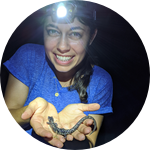About This Project
Salamanders in Europe are dying from a disease caused by the "salamander devouring fungus", Bsal. This pathogen has both swimming and encysted zoospores that can be transmitted long distances. It has not been found in the salamander biodiversity hotspot of the world, the Appalachian Mountains of North America..yet. Our research aims to understand how humans and animals can spread Bsal across a landscape and model the outcomes on fatally susceptible North American salamanders.
Ask the Scientists
Join The DiscussionWhat is the context of this research?
Currently, the "salamander devouring fungus", Bsal, is causing mass declines of salamander populations in parts of Europe, but has yet to make its way to North America, the salamander biodiversity hotspot of the world. The southeastern US in particular has favorable bioclimatic conditions for the fungus to grow, creating an optimal opportunity for unprecedented disease spread. Fungal pathogens have spread intercontinentally before (i.e., White-nose Syndrome), however; no one has yet quantified the extent to which humans may serve as a vector of spreading wildlife pathogens to novel environments. Once established, we also know that other animals (i.e., waterfowl) can spread encysted zoospores across the landscape. Therefore, we aim to quantify potential dispersal rates of Bsal.
What is the significance of this project?
These results will allow us to predict Bsal growth and spread in the currently naïve North American environment. By understanding the most likely routes for disease transmission we can generate accurate models of disease spread and implement practices to stem dispersal of Bsal to North America. Eliminating the opportunity for this pathogen to reach naïve salamander populations is our best chance to save native salamanders from Bsal driven declines and extinctions. Humans are the global common denominator and as such it is our duty to determine our role in wildlife disease spread and help stop the proliferation of another potentially catastrophic infectious disease.
What are the goals of the project?
The goals of this research are to perform laboratory experiments to quantify fungal pathogen spread across a North American "landscape" by both humans and animal vectors (e.g., waterfowl). The funds will be used to purchase the supplies required to perform landscape transmission assays in the lab and process soil and swab samples to see how much pathogen was transferred. We'll be able to quantify how much Bsal people, birds, and wild mammals are able to spread to naïve environments via physical movement. These numbers will then be used to model transmission of Bsal across a landscape where susceptible salamander species live. This will help us implement better management practices ahead of an outbreak to hopefully stop Bsal from causing declines/extinctions in North American salamanders.
Budget
The funding requested here will be used to conduct transmission experiments in the lab with people and animal proxies (e.g., duck specimens) moving through "landscapes" created in planter trays to quantify the amount of Bsal spread via physical movement. Bsal zoospores will be cultured in the lab and planter trays set up with wet and dry soil to mimic a mixed landscape design. Specific trays will be inoculated with Bsal and volunteers and proxies will then move from inoculated substrate to non-inoculated and vice versa. Samples will be taken before and after via swabbing and soil collection. We will use DNA extraction and quantitative PCR to then determine the amount of pathogen in each sample. These quantifications will then be used to model Bsal spread over geospatial data of salamander ranges and human movement. This information will help us understand how Bsal might spread if it enters the North American landscape at different locations and inform management.
Endorsed by
 Project Timeline
Project Timeline
The laboratory experiments will be conducted at the University of Florida in fall of 2021. This includes transmission assays and sample collection (i.e., swab and soil samples). Immediately following collection, samples will be processed via DNA extraction and quantitative PCR to determine pathogen load. In fall/winter 2021 these quantifications will be analyzed and put into geospatial models simulating potential spread in the North American environment.
May 31, 2021
Project Launched
Sep 20, 2021
Laboratory transmission assays
Oct 20, 2021
Finish with sample processing (extraction, qPCR)
Nov 30, 2021
Transmission models
Dec 30, 2021
Write manuscript
Meet the Team
Sarah McGrath-Blaser
I am a PhD student at the University of Florida researching amphibian diseases and am specifically interested in modes of pathogen transmission. Amphibians are under a multitude of threats, compounded by emerging infectious diseases, including those caused by the notorious chytrid fungi. I aim to use experiments in microbial ecology to understand mechanisms of transmission at the macro scale. My current research is focused in the southern Appalachian Mountain range in North America on native salamanders. However, for my masters research at James Madison University, I worked on understanding the role of vertical versus environmental transmission on the tadpole skin microbiome of foam-nest breeding frogs in Borneo. Taking the knowledge I gained from working on modes of microbial transmission in a tropical ecology context I plan to apply that to large-scale landscape transmission with my current research.
Project Backers
- 97Backers
- 105%Funded
- $4,757Total Donations
- $46.46Average Donation

